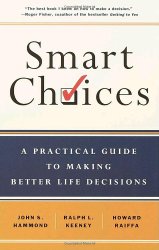Sun Aug 16 21:20:12 PDT 2015
Smart Choices - A Practical Guide to Making Better Decisions
 |
Smart Choices - A Practical Guide to Making Better Decisions by John S. Hammond, Ralph L. Keeney, Howard Raiffa
In contrast to 'Thinking For A Change', which tackles a broader subject, but winds up focused on decisions, I found this an extremely interesting read. It took me a while to get used to the style, which is verbose, though this is a short book. My initial resistance to the style was based on the fact that I have seen other, more academic books on this subject (e.g. Strategic Decision Making: Multiobjective Decision Analysis with Spreadsheets by Craig W. Kirkwood) which are quickly mathematical and algorithmic. In this case the lack of overt math and algorithm was an initial disappointment. However, once I succumbed to the style, I found the information both interesting and informative - the book helped me understand the processes of decision making better. The authors take you through many different descisions in the text - all the while documenting the decision method which can be characterized as "PrOACT" and "URL". PrOACT stands for Problem, Objective, Alternatives, Consequences, Tradeoffs - prior to reading the book I would have suspected that applying this type of breakdown to many decisions would be overkill. However, as the authors frequently mention, not all decisions require the 'full treatment' and the clarity of the steps in PrOACT does provide confidence in the application in practical situations. Here is a short summary of 'Smart Choices':
- Problem. What is the issue at hand? - always good to know - ask why several times to get to the bottom of the issue.
- Objective. What are the sizes and shapes of a successful outcomes?
- Alternatives. How might we get there? Think broadly...
- Consequences. What would these alternatives bring with them?
- Tradeoffs. How do we balance alternatives - through domination and even-swaps, to generate a simple enough analysis to be able to pick the winning choice?
(URL stands for Uncertainty, Risk and Linked decisions - as the authors probably are not interested in blogging - the acronym URL is not used in the book). That the dominant alternative and 'Even-Swap' methods reduce the complexity of alternative analysis was appealing too. There are many interesting resources on decision making on the web see the DOE decision making guidebook, for example. However, this books is worth the investment. A recommended purchase! Perhaps I am now ready (again) to tackle Craig Kirkwood's book.